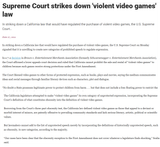Search Results
7/25/2025, 6:37:35 AM
1. Federal Statute: 18 U.S.C. § 1466A (PROTECT Act of 2003)
This law criminalizes obscene visual depictions of minors, even when no real child is involved. This includes:
>Drawings, cartoons, sculptures, and paintings If they depict a minor engaging in sexually explicit conduct and the depiction is obscene, or involves certain types of abuse (even if not obscene)
This provision was enacted after the Supreme Court struck down an earlier, broader version of the law.
2. Obscenity and the Miller Test
To determine whether material is obscene (and thus not protected by the First Amendment), courts use the Miller v. California (1973) standard:
>Prurient Interest: Would the average person, applying contemporary community standards, find that the work appeals to the prurient interest?
>Patently Offensive: Does it depict sexual conduct in a patently offensive way?
>Lacks Value: Does it lack serious literary, artistic, political, or scientific value?
If all three prongs are met, the material is legally obscene and not protected speech.
U.S. v. Whorley (4th Cir. 2008): A man was convicted for receiving Japanese manga and cartoon images of fictional minors in sexual situations. The court upheld the conviction under 18 U.S.C. § 1466A because the material was found to be obscene.
----------------------------
You're not going to force Visa to expose themselves to legal liability for facilitating monetization of illegally obscene material but that's also why the slippery slope of this extending to legal porn and violent games GTA is ridiculous
Your best recourse is pursuing alternative fin-tech infrastructures and underground work arounds
This law criminalizes obscene visual depictions of minors, even when no real child is involved. This includes:
>Drawings, cartoons, sculptures, and paintings If they depict a minor engaging in sexually explicit conduct and the depiction is obscene, or involves certain types of abuse (even if not obscene)
This provision was enacted after the Supreme Court struck down an earlier, broader version of the law.
2. Obscenity and the Miller Test
To determine whether material is obscene (and thus not protected by the First Amendment), courts use the Miller v. California (1973) standard:
>Prurient Interest: Would the average person, applying contemporary community standards, find that the work appeals to the prurient interest?
>Patently Offensive: Does it depict sexual conduct in a patently offensive way?
>Lacks Value: Does it lack serious literary, artistic, political, or scientific value?
If all three prongs are met, the material is legally obscene and not protected speech.
U.S. v. Whorley (4th Cir. 2008): A man was convicted for receiving Japanese manga and cartoon images of fictional minors in sexual situations. The court upheld the conviction under 18 U.S.C. § 1466A because the material was found to be obscene.
----------------------------
You're not going to force Visa to expose themselves to legal liability for facilitating monetization of illegally obscene material but that's also why the slippery slope of this extending to legal porn and violent games GTA is ridiculous
Your best recourse is pursuing alternative fin-tech infrastructures and underground work arounds
Page 1
